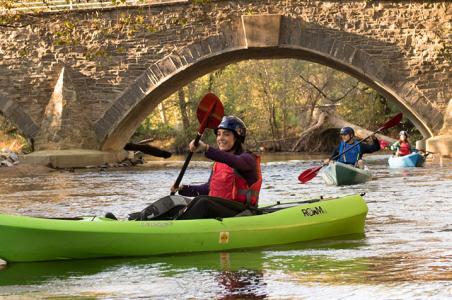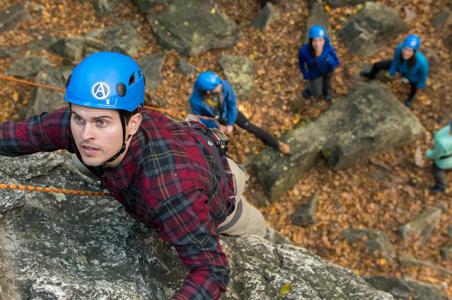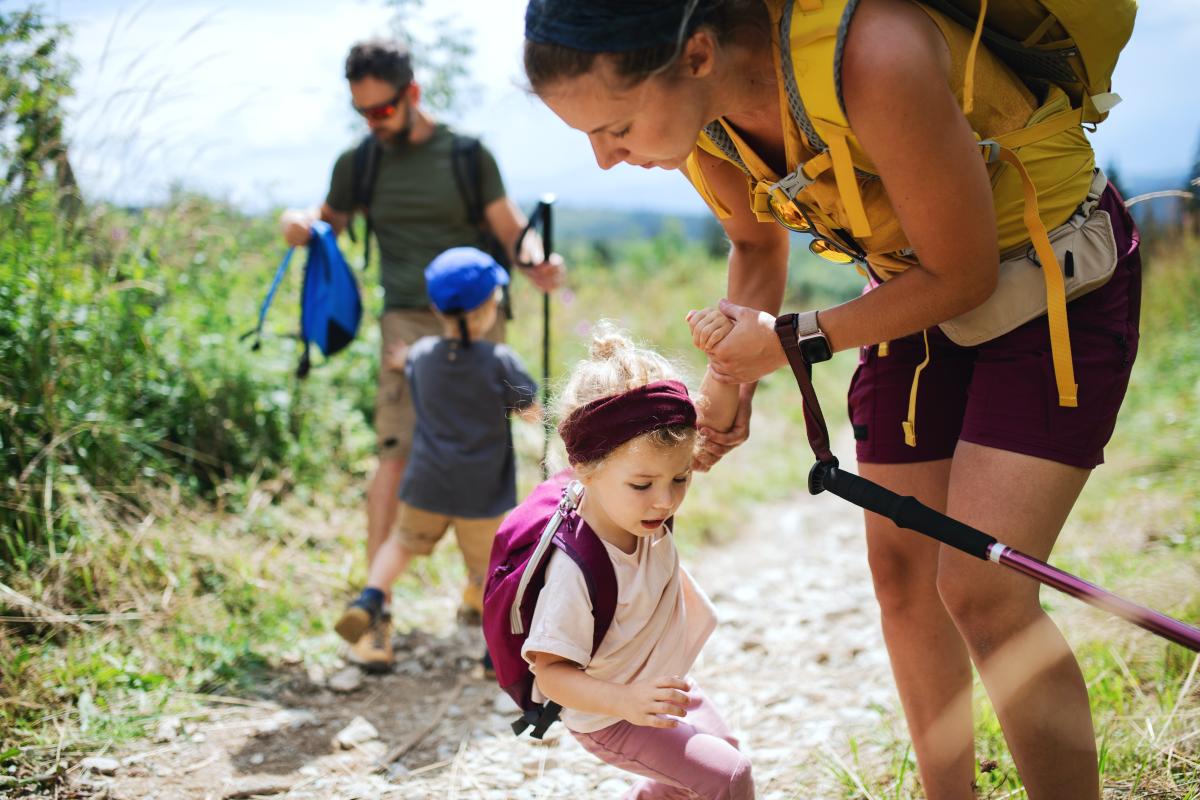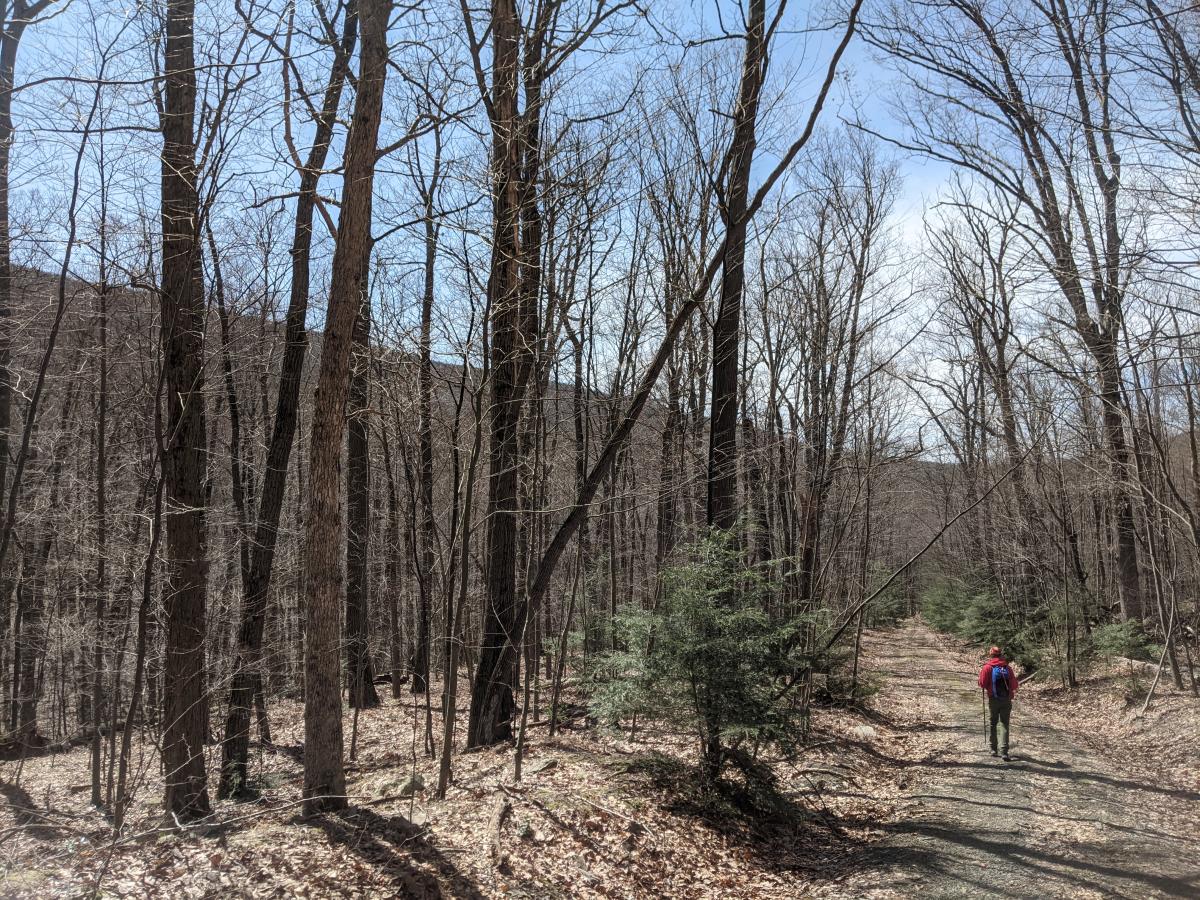When it comes to experiences shared with your children, grandchildren, or other young people in your life, few activities can rival outdoor exploration and adventure. Rich in public lands, the Cumberland Valley has plenty to offer. Despite their attachment to digital devices, many kids seem naturally attracted to spending time in nature, and hiking is a reasonably simple way to do that without significant investment. To hike safely and enjoyably, there is a right way and a wrong way to gear up – and that goes for the adults, too. When kids are involved, doing things right becomes even more critical. Their long-term relationship with nature might be hanging in the balance, as recovering from a miserable experience can be hard. Fortunately, you don't have to be an expert to help the younger crowd have a great time outside. Thankfully, the equipment required for hiking with (or without) kids is relatively minimal and generally inexpensive. Believe it or not, you likely already have most of what you need. I have enjoyed the outdoors with my son since he joined Cub Scouts at age 6. Now almost 17 and an Eagle Scout, his affinity for the outdoors is well-established. Along the way, we learned how to pack properly for a day in the woods. But, before we discuss what to pack, here are several gear-related suggestions for getting the most out of your time spent hiking with children.
The Basics
As soon as they are old enough to assume some responsibility, kids should be given some oversight over packing, carrying, and storing some of their own gear. A lightweight, comfortable day pack with various pockets, mesh water bottle storage, and the ability to include a hydration sleeve is a great investment. Teach children to pack, store and take care of their own gear. They will soon take pride in this; after a few seasons, you won't need to remind them what to bring.
It is a great practice to keep your day packs ready to go at all times, stocked with a baseline level of gear. Then, add a few things like food, water, and extra clothing layers as needed for a given trip. Preparing this way allows spur-of-the-moment hikes. Keep non-perishable consumables and supplies in zipper-closure freezer bags to keep them dry. For things like sunscreen and hand sanitizer, repackage into smaller, refillable containers, leave them in your day pack, and freshen them up occasionally.
While this post is more about gear than clothes, shoes are worth mentioning, as so much of a child's hiking comfort will hinge on footwear. If you are hiking under typical 3-season conditions and the wearer has ankles of at least average strength, there is little need for heavy, bulky high-top hiking boots. Trail runners can be more comfortable, are less prone to cause blisters, are lighter, and will dry out faster. On the flip side, some hikers find wearing actual hiking boots more reassuring where the terrain is exceptionally rocky. Regarding waterproofing, keep in mind that it goes both ways. Waterproof boots prevent most water from getting in, but if moisture does actually get in somehow, it can't get out.
10 Essentials
And now for the actual gear. Since my son is an Eagle Scout and I am a "Scouter" (BSA-speak for an adult volunteer), starting with the Boy Scouts "Ten Essentials" seems a natural place to begin. Keep in mind that some items don't need to be duplicated. Not everyone in a group of hikers needs to bring everything.
1. Pocket knife
This is so you can cut a piece of cheese, a bandage, or a cord. Some even come with a small screwdriver, scissors, etc. Older kids who know how to use one safely may have fun whittling when taking a break. A small, sharp pocket knife is also suitable for an emergency if you need to start a fire and the wood is wet.
2. First-aid kit
Make sure it has the basics (do a bit of online searching) and includes blister care items and tweezers for the occasional splinter or tick.
3. Extra clothing appropriate for the season
Moisture-wicking fabrics and other synthetics are great; so is wool. Bring windproof and waterproof layers depending on the conditions. Fleece is an efficient, lightweight, fast-drying warmth layer for any season. Avoid cotton most of the time, as it retains moisture and can present a dangerous hypothermia risk in cooler weather. Follow these same principles with the clothing you wear on your body, not just the extra layers in your pack.
4. Rain gear
For most local day hikes on which you're likely to bring your kids, a cheap emergency poncho should be sufficient, but check that forecast to be safe. As a bonus, an emergency poncho will cover both you and your day pack to keep your gear dry as well.
5. Flashlight
This is more of an emergency item since you're not likely to be out at night. However, you may also want to check into a dark space for snakes. Go for small and light, whether a flashlight or a headlamp. Our favorites tend to have 2-3 replaceable AAA batteries and offer several hundred lumens of brightness.
6. Trail food/snacks
Calorie-dense foods with carbs and protein are good. Think nuts, cured meats, granola bars, hard cheeses (in colder weather), and the like. Bring a few treats, too. Plan on burning several hundred calories per hour. With kids, it's always better to bring more food than not enough.
7. Water
Bring enough for the trip or water filter/purification tablets if you replenish along the way. A means of water purification is good to have on hand in case of an emergency. Plain old 16–20-ounce disposable plastic bottles are just fine for a hike; bring 2-3 per person depending on the length of the hike and the conditions, erring on the side of too much if need be (maybe throw a few extra in the car for when you're done hiking).
8. Matches/lighter and a fire starter
These are generally more for emergencies during day hikes but are good to have in case you need to get warm quickly.
9. Sun protection
Sunblock and a wide-brimmed hat will keep everyone comfortable from the intense rays.
10. Map and compass
Even if you know the area well and have a zero percent chance of getting lost, using a map and compass is a great teachable moment for kids. After learning the basics of reading a map, a simple orienteering task can be fun and challenging, such as orienting a map to the terrain and identifying things like distant hills. It is very helpful if your map has contour lines to help gauge the landscape. Most PA state parks and forests offer free maps with decent detail. If you want to learn more about orienteering, get a compass with a see-through plastic baseplate and a rotating bezel and learn how to use it; this type is far more effective paired up with a map than the kind that looks like an oversized pocket watch with a flip-lid.
More Suggestions
I also recommend considering the following:
Hand sanitizer, wipes, etc.
This is for when your kid picks up that toad or snatches a gross algae-covered rock out of the pond (or maybe you do, too). And let's not forget potty breaks! Arguably a part of the first aid kit in the "Ten Essentials," it's worth mentioning the sanitizer separately since you know the kids - and probably you - will be getting their hands dirty.
A few plastic zipper-close bags
You can use a few for packing some of your gear to keep it waterproof but bring some extras. They make great trash bags, to name one use. We prefer freezer bags for repeated storage use, as they are a bit heftier than regular storage bags, both in the plastic's quality and the zipper closure's sturdiness.
Several plastic grocery bags
A few of these go a long way towards wrapping up things like wet socks or anything else you want to keep separate from the rest of your pack. Using a grocery bag for this purpose is a great way to recycle something that might get tossed otherwise.
Small notebook and pencil
Besides taking the occasional notes, I consider this piece of "gear" essential for jotting down ideas for what I'd pack or do differently next time, locations of campsites, or thoughts of where to explore on the next trip. I have taken this approach with hiking, camping, and overnight backpacking, and my little notebook has never failed to be one of my most essential items.
Tarp and 50’ of paracord
Now we're getting a bit more serious, but this is very useful for rigging an emergency shelter to wait out a storm and many other things. Learn at least the taut line hitch, alpine butterfly knot, bowline, and sheet bend, and teach them to your kids. You and your kids will have a useful skill, and they will think you are awesome (at least until they are ten or so). And yes, practicing knots is yet another excellent side activity for kids.
TP and trowel
I can speak from experience that this is absolutely essential. A plastic garden trowel may be sufficient but slightly flimsy if the ground is rocky or crisscrossed with many roots. Outfitters sell backpacking trowels that are more durable and even lighter. Make sure you understand any area regulations and know how to practice "Leave No Trace" principles. The DCNR publishes guidelines on proper waste disposal for PA state forest hikers.
Bug protection
This is probably also implied in the Boy Scouts' first aid supplies listed above, but as with hand sanitizer, it pays to list this one separately when hiking with kids. Use a kid-safe repellent for the skin. You can treat clothing with permethrin to lessen the chances of getting ticks
Miscellaneous emergency and repair items
We're talking about a few feet of duct tape, spare batteries, a whistle, dry tinder for a fire, etc. Researching and making a small emergency/survival kit is also a fun activity for the kids in preparing for a hike.
Optional Items
Finally, here are some optional and/or fun Items that have the potential to make the trip a bit more comfortable or more interesting, at least in our experience.
Trekking poles
While not strictly necessary, trekking poles can be beneficial for maintaining balance, particularly when hiking downhill, crossing streams, or walking in areas with loose rocks (rocks in Pennsylvania, who knew?). Also, did you know that hiking with trekking poles is better exercise because it moves your upper body, too?
Binoculars or a scope
These are used for viewing wildlife or other natural features.
Animal and tree identification books, cards, etc.
If your child is into identifying animals, plants, and such, this can be a fun thing to have on hand. Of course, you can do this on your phone - if you can get the internet. Don't count on that, though.
Carabiners
Carabiners can be very helpful to clip things onto your backpack and have many other uses, from shelter-building to bear-bag-hanging (not generally needed for day hikes, but a great skill to know and teach the kids, nevertheless).
Backpacking stove
Done safely, on-trail cooking can add another fun dimension to any outing for parents and kids alike. If they are old enough, the kids can even help. Learn a few simple, lightweight grocery store backpacking meals. If cooking, don't forget to have each hiker bring a bowl (a 16 oz plastic, disposable food storage bowl without the lid is a great lightweight and cheap alternative) and a spork. Ensure you learn how to use your stove correctly before taking it on the trail.
Chair
Yes, a chair. I have a rather pricey backpacking chair for overnight trips that weighs a mere pound, but given that you don't carry nearly as much gear for a day hike, a casual hiker can probably afford to pack an extra pound or two and save on this purchase. Also, a chair can be nice on a long hike if you want to take a break and stretch your legs without being on the ground. I've even sat on mine in the middle of a stream.
A small plastic box with a secure lid
My son would always find a cool fallen leaf or pine cone or something for his collection that would otherwise get crushed in his pack. Just make sure anything you keep doesn't have bugs or eggs on it. Do not pack out wildlife!
Carriers and diaper supplies
If you're hiking with very young children, you'll need to plan accordingly.
Kid-Friendly Hikes
Hiking with kids can be tremendously rewarding. We hope this list helps encourage you to step out onto the trail. To help you plan for your outdoor adventure, check out these kid-friendly hikes in Cumberland Valley.
About the Author
Scott Gehman is a local camping and backpacking enthusiast. Having done some camping as a kid and a teenager, he really got into it when his son Tom joined the Cub Scouts back in 2012. Scott and Tom have since gone on to enjoy a wide variety of tent camping and backpacking experiences right here in south-central PA, both with and without Tom’s Boy Scout troop. Scott is a Retirement Plan Consultant for Conrad Siegel in Harrisburg and lives in Carlisle with his wife and two kids. Not wanting to live out of sync with Carlisle’s car culture, Scott’s main form of transportation is his Mustang GT, which makes for some quizzical looks from fellow campers when pulling up to a site. He always calls the forest ranger before he leaves it at a trailhead in the middle of the woods for a backpacking trip!










